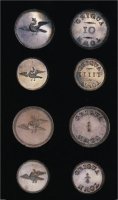The Griquatown Day and Half-Day tokens
One of the greatest anomalies relating to the Griquatown silver tokens is the values of TEN and FIVE.
 In the past it has been suggested that these values were some form of romantic and forward thinking form of decimalization. I have never bought that theory, which has no factual basis or historical foundation, especially when one considers the gap between the HALF (bronze) and the FIVE (silver). I have pondered long and hard as to an alternative answer, and I think that I might have it. The answer is astonishingly simple and makes perfect sense.
In the past it has been suggested that these values were some form of romantic and forward thinking form of decimalization. I have never bought that theory, which has no factual basis or historical foundation, especially when one considers the gap between the HALF (bronze) and the FIVE (silver). I have pondered long and hard as to an alternative answer, and I think that I might have it. The answer is astonishingly simple and makes perfect sense.
Now if one looks at the early tokens of South Africa - tokens like the George Divisional Council Day and Half day tokens, the Montagu Divisional Council Day and Half Day tokens, the Larkan Bobbin day tokens etc.. we see that they were introduced in a manner that the largely uneducated indigenous people working for these people could relate to. A TOKEN OF VALUE BASED ON TIME WORKED.
The more I look at the words FIVE and TEN on the Griquatown tokens the more I see FIVE HOURS (half a day) and TEN HOURS (a full day) work. The bronze pieces, which there is no contemporary record of anywhere, could well have represented QUARTER of an hour or fifteen minutes work and HALF an hour or thirty minutes work (payment in bronze Griquatown tokens for small tasks). That would give a logical explanation to the large gap between the HALF and the FIVE. These were not some sort of evolutionary currency pieces but labour tokens representing time worked. The inherent value of the silver in the coin could well have been one of the first (unrecorded) "labour disputes" in South Africa as it is known that the missionaries could not establish the real "value" of the FIVE and TEN - Helm mentions this in a letter to the London Missionary Society.
I guess we will never know the truth but I believe that a time based representation on the coins makes far more sense as that "value" would have been better understood by the Griqua as a form of payment by the Missionaries for their labour. If the tokens had been holed (like many tokens were in the 1800s) that might also have helped Campbell's cause - but they weren't and the tokens failed to circulate because no trading stores south of the Orange River would accept them (there were no places to trade them for goods in Griquatown). For the labourers at Griquatown the basic needs of a full tummy for work done would have far outweighed the alternative of the ownership of a silver coin which could not be exchanged for food and which could so easily be lost. I think that we can all relate to that point of view if we were in that remote part of the world at that time!
PLEASE NOTE I have no facts to support my suggestions here regarding the values on the Griquatown coins but, considering the environment, a time/labour based value makes a lot more sense than some visionary decimalization currency.
More at this link
Return to articles
 In the past it has been suggested that these values were some form of romantic and forward thinking form of decimalization. I have never bought that theory, which has no factual basis or historical foundation, especially when one considers the gap between the HALF (bronze) and the FIVE (silver). I have pondered long and hard as to an alternative answer, and I think that I might have it. The answer is astonishingly simple and makes perfect sense.
In the past it has been suggested that these values were some form of romantic and forward thinking form of decimalization. I have never bought that theory, which has no factual basis or historical foundation, especially when one considers the gap between the HALF (bronze) and the FIVE (silver). I have pondered long and hard as to an alternative answer, and I think that I might have it. The answer is astonishingly simple and makes perfect sense.